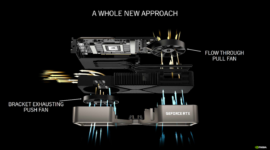AMD Big Navi “Navi 21” GPU For Flagship Radeon R9 6900 XT Graphics Card
Powered by the RDNA2 architecture, the Big Navi GPU is massive in size when compared to past AMD flagship GPU offerings. The AMD Big Navi GPU is around 536mm2. The Navi 21 XT and XL will be featuring standard GDDR6 configurations while the Navi 21 XTX is going to utilize HBM2(e) sub-system for memory but that has not been confirmed yet. It would feature 16 GB of GDDR6 memory across a 256-bit bus interface.
16 GB VRAM is also possible with a 512-bit interface so AMD is also open to that option when the final specifications are released. AMD is providing a handful of teaser and leaks in the meanwhile. As for the designs themselves, the Radeon RX 6000 flagship cooling design looks amazing with the red and black design. The card features a triple axial-tech fan setup on the shroud and has a large aluminum heatsink that runs beneath it.
The card has a LED-lit Radeon logo on the side and there is a large cut out on the side for the fans to vent out hot air. This design is very reminiscent of the NVIDIA GeForce RTX 20 series Founders Edition cooler. The card will feature dual 8-pin power and display ports would include a USB Type-C, 1 HDMI, and 2 DisplayPort connectors. The card also features a fancy backplate along with a retention bracket to hold the cooler in place.
The Radeon RX “Big Navi” GPU looks like it will come in the standard 2-slot reference design which is the same as NVIDIA’s flagship RTX 3080 but not as huge as the triple-slot GeForce RTX 3090.
The AMD RDNA 2 based Radeon RX Navi 2x graphics card family is also touted to disrupt the 4K gaming segment similar to how Ryzen disrupted the entire CPU landscape. That is a pretty bold claim from AMD themselves but leaks and rumors are suggesting that this might be the case for its next-generation Radeon RX graphics cards. AMD unveiled that its RDNA 2 GPUs will deliver a similar performance jump over the first-generation RDNA GPUs like Zen 2 delivered over Zen 1.
The first RDNA GPUs delivered a massive 50% increase in performance per watt over GCN architecture and RDNA 2 GPUs are expected to do the same over RDNA 1, delivering another 50% increase in performance per watt. The RDNA 2 GPUs would feature three key features that will be part of the new GPU architecture. First and foremost is the performance per watt increase which is due to a number of reasons.
AMD will be shifting from TSMC’s 7nm process to the more advanced 7nm process node. The new process node itself increases transistor efficiency on the new GPUs while decreasing its overall size, allowing AMD to cram more performance in a much smaller package. The key changes that have led to a 50% increase in performance per watt include a redesigned micro-architecture with improved performance-per-clock (IPC), a logic enhancement that helps reduce design complexity and switching power, and physical optimizations such as increased clock speeds.
AMD has also announced that RDNA 2 GPUs would feature VRS (Variable Rate Shading) and hardware-accelerated ray tracing.
AMD is following suit with NVIDIA which had already implemented the technologies on its Turing GPU based GeForce RTX graphics cards. With the launch of the new consoles from Microsoft and Sony imminent, AMD is going to work to provide these features with its own optimization framework to developers for integration within next-generation gaming titles. AMD has also recently showcased its RDNA 2 GPUs running Microsoft‘s DXR 1.1 demo internally which utilizes hardware-accelerated ray tracing.
AMD’s approach to ray tracing is to offer simplified development and speedy adopting and that is definitely possible through consoles where the mass majority of game developers focus their efforts towards. A new RDNA 2 GPU based Radeon RX high-end family and a 7nm RDNA refresh family will be launched in 2020. The “Navi 2x” lineup would scale from top to bottom and deliver twice the performance efficiency increase over the first-generation RX graphics cards.
The RDNA 2 GPU based Radeon RX products for the PC platform will be first to get a taste of the new architecture in the form of the Big Navi graphics card followed by mainstream GPUs. Some of the features from 2nd Generation RDNA Navi GPUs would be optimized 7nm process node, enthusiast-grade desktop graphics card options, hardware-Level Ray Tracing Support, a mix of GDDR6 graphics cards, and more power-efficient than First-Gen Navi GPUs. One of the key features on the Big Navi Radeon RX GPU is that it is going to disrupt the 4K gaming segment, similar to how Ryzen disrupted the entire CPU segment.
AMD emphasized enthusiast-class performance for the RDNA 2 based Radeon RX ‘Navi 2X’ GPUs.
AMD will officially be unveiling its Radeon RX 6000 series graphics card family on October 28th 2020.

